Management of Carotid Artery Trauma
Abstract
Overview
Anatomy
Blunt Extracranial Carotid Artery Trauma
Epidemiology and Pathophysiology
Presentation and Natural Progression of Blunt ECAI
Screening Criteria
Screening Modality
Treatment
Penetrating Extracranial Carotid Artery Trauma
Intracranial Carotid Artery Trauma
Conclusion
References
- Kraus, R.R.; Bergstein, J.M.; DeBord, J.R. Diagnosis, treatment, and outcome of blunt carotid arterial injuries. Am J Surg 1999, 178, 190–193. [Google Scholar] [CrossRef] [PubMed]
- Biousse, V.; D’Anglejan-Chatillon, J.; Touboul, P.J.; Amarenco, P.; Bousser, M.G. Time course of symptoms in extracranial carotid artery dissections. A series of 80 patients. Stroke 1995, 26, 235–239. [Google Scholar] [CrossRef] [PubMed]
- Dua, A.; Desai, S.S.; Kuy, S.; et al. Predicting outcomes using the National Trauma Data Bank: optimum management of traumatic blunt carotid and blunt thoracic injury. Perspect Vasc Surg Endovasc Ther 2012, 24, 123–127. [Google Scholar] [CrossRef]
- Schneidereit, N.P.; Simons, R.; Nicolaou, S.; et al. Utility of screening for blunt vascular neck injuries with computed tomographic angiography. J Trauma 2006, 60, 209–215, discussion 215–216. [Google Scholar] [CrossRef] [PubMed]
- Cogbill, T.H.; Moore, E.E.; Meissner, M.; et al. The spectrum of blunt injury to the carotid artery: a multicenter perspective. J Trauma 1994, 37, 473–479. [Google Scholar] [CrossRef]
- Li, W.; D’Ayala, M.; Hirshberg, A.; Briggs, W.; Wise, L.; Tortolani, A. Comparison of conservative and operative treatment for blunt carotid injuries: analysis of the National Trauma Data Bank. J Vasc Surg 2010, 51, 593–599, e1–e2. [Google Scholar] [CrossRef]
- Bouthillier, A.; van Loveren, H.R.; Keller, J.T. Segments of the internal carotid artery: a new classification. Neurosurgery 1996, 38, 425–432, discussion 432–433. [Google Scholar]
- Davis, J.W.; Holbrook, T.L.; Hoyt, D.B.; Mackersie, R.C.; Field, T.O., Jr.; Shackford, S.R. Blunt carotid artery dissection: incidence, associated injuries, screening, and treatment. J Trauma 1990, 30, 1514–1517. [Google Scholar] [CrossRef]
- Fabian, T.C.; Patton JHJr Croce, M.A.; Minard, G.; Kudsk, K.A.; Pritchard, F.E. Blunt carotid injury. Importance of early diagnosis and anticoagulant therapy. Ann Surg 1996, 223, 513–522, discussion 522–525. [Google Scholar] [CrossRef]
- Biffl, W.L.; Moore, E.E.; Ryu, R.K.; et al. The unrecognized epidemic of blunt carotid arterial injuries: early diagnosis improves neurologic outcome. Ann Surg 1998, 228, 462–470. [Google Scholar] [CrossRef]
- Miller, P.R.; Fabian, T.C.; Croce, M.A.; et al. Prospective screening for blunt cerebrovascular injuries: analysis of diagnostic modalities and outcomes. Ann Surg 2002, 236, 386–393, discussion 393–395. [Google Scholar] [CrossRef] [PubMed]
- Kerwin, A.J.; Bynoe, R.P.; Murray, J.; et al. Liberalized screening for blunt carotid and vertebral artery injuries is justified. J Trauma 2001, 51, 308–314. [Google Scholar] [CrossRef]
- Biffl, W.L.; Ray CEJr Moore, E.E.; et al. Treatment-related outcomes from blunt cerebrovascular injuries: importance of routine follow-up arteriography. Ann Surg 2002, 235, 699–706, discussion 706–707. [Google Scholar] [CrossRef]
- Berne, J.D.; Reuland, K.S.; Villarreal, D.H.; McGovern, T.M.; Rowe, S.A.; Norwood, S.H. Sixteen-slice multi-detector computed tomographic angiography improves the accuracy of screening for blunt cerebrovascular injury. J Trauma 2006, 60, 1204–1209, discussion 1209–1210. [Google Scholar] [CrossRef] [PubMed]
- Eastman, A.L.; Chason, D.P.; Perez, C.L.; McAnulty, A.L.; Minei, J.P. Computed tomographic angiography for the diagnosis of blunt cervical vascular injury: is it ready for primetime? J Trauma 2006, 60, 925–929, discussion 929. [Google Scholar] [CrossRef] [PubMed]
- Crissey, M.M.; Bernstein, E.F. Delayed presentation of carotid intimal tear following blunt craniocervical trauma. Surgery 1974, 75, 543–549. [Google Scholar]
- Zelenock, G.B.; Kazmers, A.; Whitehouse, W.M., Jr.; et al. Extracranial internal carotid artery dissections: noniatrogenic traumatic lesions. Arch Surg 1982, 117, 425–432. [Google Scholar] [CrossRef]
- Anson, J.; Crowell, R.M. Cervicocranial arterial dissection. Neurosurgery 1991, 29, 89–96. [Google Scholar] [CrossRef]
- Raser, J.M.; Mullen, M.T.; Kasner, S.E.; Cucchiara, B.L.; Messé, S.R. Cervical carotid artery dissection is associated with styloid process length. Neurology 2011, 77, 2061–2066. [Google Scholar] [CrossRef]
- Biffl, W.L.; Moore, E.E.; Offner, P.J.; Burch, J.M. Blunt carotid and vertebral arterial injuries. World J Surg 2001, 25, 1036–1043. [Google Scholar] [CrossRef]
- Stein, D.M.; Boswell, S.; Sliker, C.W.; Lui, F.Y.; Scalea, T.M. Blunt cerebrovascular injuries: does treatment always matter? J Trauma 2009, 66, 132–143, discussion 143–144. [Google Scholar] [CrossRef] [PubMed]
- McKevitt, E.C.; Kirkpatrick, A.W.; Vertesi, L.; Granger, R.; Simons, R.K. Blunt vascular neck injuries: diagnosis and outcomes of extracranial vessel injury. J Trauma 2002, 53, 472–476. [Google Scholar] [CrossRef]
- Burlew, C.C.; Biffl, W.L.; Moore, E.E.; Barnett, C.C.; Johnson, J.L.; Bensard, D.D. Blunt cerebrovascular injuries: redefining screening criteria in the era of noninvasive diagnosis. J Trauma Acute Care Surg 2012, 72, 330–335, discussion 336–337, quiz 539. [Google Scholar] [CrossRef]
- Zetterling, M.; Carlström, C.; Konrad, P. Internal carotid artery dissection. Acta Neurol Scand 2000, 101, 1–7. [Google Scholar] [CrossRef] [PubMed]
- Srinivasan, J.; Newell, D.W.; Sturzenegger, M.; Mayberg, M.R.; Winn, H.R. Transcranial Doppler in the evaluation of internal carotid artery dissection. Stroke 1996, 27, 1226–1230. [Google Scholar] [CrossRef] [PubMed]
- Scheid, R.; Zimmer, C.; Schroeter, M.L.; Ballaschke, O.; von Cramon, D.Y. The clinical spectrum of blunt cerebrovascular injury. Neurologist 2006, 12, 255–262. [Google Scholar] [CrossRef] [PubMed]
- Okada, Y.; Shima, T.; Nishida, M.; Yamane, K.; Kagawa, R. Traumatic dissection of the common carotid artery after blunt injury to the neck. Surg Neurol 1999, 51, 513–519, discussion 519–520. [Google Scholar] [CrossRef]
- Biffl, W.L.; Moore, E.E.; Offner, P.J.; Brega, K.E.; Franciose, R.J.; Burch, J.M. Blunt carotid arterial injuries: implications of a new grading scale. J Trauma 1999, 47, 845–853. [Google Scholar] [CrossRef]
- Miller, P.R.; Fabian, T.C.; Bee, T.K.; et al. Blunt cerebrovascular injuries: diagnosis and treatment. J Trauma 2001, 51, 279–285, discussion 285–286. [Google Scholar] [CrossRef]
- Cothren, C.C.; Moore, E.E.; Biffl, W.L.; et al. Anticoagulation is the gold standard therapy for blunt carotid injuries to reduce stroke rate. Arch Surg 2004, 139, 540–545, discussion 545–546. [Google Scholar] [CrossRef]
- Biffl, W.L.; Moore, E.E.; Offner, P.J.; Brega, K.E.; Franciose, R.J.; Burch, J.M. Therapeutic implications of a new grading scale in 100 blunt carotid arterial injuries. J Trauma Inj Infect Crit Care 1999, 46, 201. [Google Scholar] [CrossRef]
- Biffl, W.L.; Cothren, C.C.; Moore, E.E.; et al. Western Trauma Association critical decisions in trauma: screening for and treatment of blunt cerebrovascular injuries. J Trauma 2009, 67, 1150–1153. [Google Scholar] [CrossRef]
- Bromberg, W.J.; Collier, B.C.; Diebel, L.N.; et al. Blunt cerebrovascular injury practice management guidelines: the Eastern Association for the Surgery of Trauma. J Trauma 2010, 68, 471–477. [Google Scholar] [CrossRef] [PubMed]
- Berne, J.D.; Norwood, S.H.; McAuley, C.E.; Vallina, V.L.; Creath, R.G.; McLarty, J. The high morbidity of blunt cerebrovascular injury in an unscreened population: more evidence of the need for mandatory screening protocols. J Am Coll Surg 2001, 192, 314–321. [Google Scholar] [CrossRef]
- Biffl, W.L.; Moore, E.E.; Offner, P.J.; et al. Optimizing screening for blunt cerebrovascular injuries. Am J Surg 1999, 178, 517–522. [Google Scholar] [CrossRef] [PubMed]
- Mulligan, R.P.; Friedman, J.A.; Mahabir, R.C. A nationwide review of the associations among cervical spine injuries, head injuries, and facial fractures. J Trauma 2010, 68, 587–592. [Google Scholar] [CrossRef]
- Mutze, S.; Rademacher, G.; Matthes, G.; Hosten, N.; Stengel, D. Blunt cerebrovascular injury in patients with blunt multiple trauma: diagnostic accuracy of duplex Doppler US and early CT angiography. Radiology 2005, 237, 884–892. [Google Scholar] [CrossRef]
- McKevitt, E.C.; Kirkpatrick, A.W.; Vertesi, L.; Granger, R.; Simons, R.K. Identifying patients at risk for intracranial and extracranial blunt carotid injuries. Am J Surg 2002, 183, 566–570. [Google Scholar] [CrossRef]
- Cothren, C.C.; Moore, E.E.; Ray, C.E., Jr.; et al. Screening for blunt cerebrovascular injuries is cost-effective. Am J Surg 2005, 190, 845–849. [Google Scholar] [CrossRef]
- Kaye, D.; Brasel, K.J.; Neideen, T.; Weigelt, J.A. Screening for blunt cerebrovascular injuries is cost-effective. J Trauma 2011, 70, 1051–1056, discussion 1056–1057. [Google Scholar] [CrossRef]
- Harrigan, M.R.; Weinberg, J.A.; Peaks, Y.S.; et al. Management of blunt extracranial traumatic cerebrovascular injury: a multidisciplinary survey of current practice. World J Emerg Surg 2011, 6, 11. [Google Scholar] [CrossRef] [PubMed]
- DiCocco, J.M.; Emmett, K.P.; Fabian, T.C.; Zarzaur, B.L.; Williams, J.S.; Croce, M.A. Blunt cerebrovascular injury screening with 32-channel multidetector computed tomography: more slices still don’t cut it. Ann Surg 2011, 253, 444–450. [Google Scholar] [CrossRef] [PubMed]
- Biffl, W.L.; Egglin, T.; Benedetto, B.; Gibbs, F.; Cioffi, W.G. Sixteen-slice computed tomographic angiography is a reliable noninvasive screening test for clinically significant blunt cerebrovascular injuries. J Trauma 2006, 60, 745–751, discussion 751–752. [Google Scholar] [CrossRef]
- Utter, G.H.; Hollingworth, W.; Hallam, D.K.; Jarvik, J.G.; Jurkovich, G.J. Sixteen-slice CT angiography in patients with suspected blunt carotid and vertebral artery injuries. J Am Coll Surg 2006, 203, 838–848. [Google Scholar] [CrossRef]
- Malhotra, A.K.; Camacho, M.; Ivatury, R.R.; et al. Computed tomographic angiography for the diagnosis of blunt carotid/vertebral artery injury: a note of caution. Ann Surg 2007, 246, 632–642, discussion 642–643. [Google Scholar] [CrossRef]
- Goodwin, R.B.; Beery, P.R.I.I.; Dorbish, R.J.; et al. Computed tomographic angiography versus conventional angiography for the diagnosis of blunt cerebrovascular injury in trauma patients. J Trauma 2009, 67, 1046–1050. [Google Scholar] [CrossRef] [PubMed]
- Roberts, D.J.; Chaubey, V.P.; Zygun, D.A.; et al. Diagnostic accuracy of computed tomographic angiography for blunt cerebrovascular injury detection in trauma patients: a systematic review and meta-analysis. Ann Surg 2013, 257, 621–632. [Google Scholar] [CrossRef]
- Chamoun, R.B.; Mawad, M.E.; Whitehead, W.E.; Luerssen, T.G.; Jea, A. Extracranial traumatic carotid artery dissections in children: a review of current diagnosis and treatment options. J Neurosurg Pediatr 2008, 2, 101–108. [Google Scholar] [CrossRef]
- Biffl, W.L.; Ray CEJr Moore, E.E.; Mestek, M.; Johnson, J.L.; Burch, J.M. Noninvasive diagnosis of blunt cerebrovascular injuries: a preliminary report. J Trauma 2002, 53, 850–856. [Google Scholar] [CrossRef]
- Colella, J.J.; Diamond, D.L. Blunt carotid injury: reassessing the role of anticoagulation. Am Surg 1996, 62, 212–217. [Google Scholar]
- Edwards, N.M.; Fabian, T.C.; Claridge, J.A.; Timmons, S.D.; Fischer, P.E.; Croce, M.A. Antithrombotic therapy and endovascular stents are effective treatment for blunt carotid injuries: results from long term followup. J Am Coll Surg 2007, 204, 1007–1013, discussion 1014–1015. [Google Scholar] [CrossRef] [PubMed]
- Eachempati, S.R.; Vaslef, S.N.; Sebastian, M.W.; Reed, R.L. II. Blunt vascular injuries of the head and neck: is heparinization necessary? J Trauma 1998, 45, 997–1004. [Google Scholar] [CrossRef] [PubMed]
- Wahl, W.L.; Brandt, M.M.; Thompson, B.G.; Taheri, P.A.; Greenfield, L.J. Antiplatelet therapy: an alternative to heparin for blunt carotid injury. J Trauma 2002, 52, 896–901. [Google Scholar] [CrossRef]
- Beletsky, V.; Nadareishvili, Z.; Lynch, J.; Shuaib, A.; Woolfenden, A.; Norris, J.W.; Canadian Stroke Consortium. Cervical arterial dissection: time for a therapeutic trial? Stroke 2003, 34, 2856–2860. [Google Scholar] [CrossRef] [PubMed]
- Hinson, H.E.; Stallmeyer, M.J.; Furuno, J.P.; Yarbrough, K.L.; Cole, J.W. Antithrombotic therapy and outcomes of cervical arterial dissection in the trauma patient: a case series. J Trauma Manag Outcomes 2010;4, 4, 13. [Google Scholar] [CrossRef] [PubMed]
- Pham, M.H.; Rahme, R.J.; Arnaout, O.; et al. Endovascular stenting of extracranial carotid and vertebral artery dissections: a systematic review of the literature. Neurosurgery 2011, 68, 856–866, discussion 866. [Google Scholar] [CrossRef]
- Cothren, C.C.; Moore, E.E.; Ray, C.E., Jr.; et al. Carotid artery stents for blunt cerebrovascular injury: risks exceed benefits. Arch Surg 2005, 140, 480–485, discussion 485–486. [Google Scholar] [CrossRef]
- Kadkhodayan, Y.; Moran, C.J.; Derdeyn, C.P.; Cross, D.T., III. Outcomes of angioplasty and stenting at the common carotid origin. Surg Neurol 2009, 72, 451–455, discussion 455. [Google Scholar] [CrossRef]
- Liu, A.Y.; Paulsen, R.D.; Marcellus, M.L.; Steinberg, G.K.; Marks, M.P. Longterm outcomes after carotid stent placement treatment of carotid artery dissection. Neurosurgery 1999, 45, 1368–1373, discussion 1373–1374. [Google Scholar] [CrossRef]
- Coldwell, D.M.; Novak, Z.; Ryu, R.K.; et al. Treatment of posttraumatic internal carotid arterial pseudoaneurysms with endovascular stents. J Trauma 2000, 48, 470–472. [Google Scholar] [CrossRef]
- Yi, A.C.; Palmer, E.; Luh, G.Y.; Jacobson, J.P.; Smith, D.C. Endovascular treatment of carotid and vertebral pseudoaneurysms with covered stents. AJNR Am J Neuroradiol 2008, 29, 983–987. [Google Scholar] [CrossRef]
- Duke, B.J.; Ryu, R.K.; Coldwell, D.M.; Brega, K.E. Treatment of blunt injury to the carotid artery by using endovascular stents: an early experience. J Neurosurg 1997, 87, 825–829. [Google Scholar] [CrossRef]
- Seth, R.; Obuchowski, A.M.; Zoarski, G.H. Endovascular repair of traumatic cervical internal carotid artery injuries: a safe and effective treatment option. AJNR Am J Neuroradiol 2013, 34, 1219–1226. [Google Scholar] [CrossRef]
- Kadkhodayan, Y.; Jeck, D.T.; Moran, C.J.; Derdeyn, C.P.; Cross, D.T., III. Angioplasty and stenting in carotid dissection with or without associated pseudoaneurysm. AJNR Am J Neuroradiol 2005, 26, 2328–2335. [Google Scholar] [PubMed]
- Lavallée, P.C.; Mazighi, M.; Saint-Maurice, J.P.; et al. Stent-assisted endovascular thrombolysis versus intravenous thrombolysis in internal carotid artery dissection with tandem internal carotid and middle cerebral artery occlusion. Stroke 2007, 38, 2270–2274. [Google Scholar] [CrossRef] [PubMed]
- DuBose, J.; Recinos, G.; Teixeira, P.G.; Inaba, K.; Demetriades, D. Endovascular stenting for the treatment of traumatic internal carotid injuries: expanding experience. J Trauma 2008, 65, 1561–1566. [Google Scholar] [CrossRef] [PubMed]
- Cohen, J.E.; Gomori, J.M.; Itshayek, E.; et al. Single-center experience on endovascular reconstruction of traumatic internal carotid artery dissections. J Trauma Acute Care Surg 2012, 72, 216–221. [Google Scholar] [CrossRef]
- Demetriades, D.; Asensio, J.A.; Velmahos, G.; Thal, E. Complex problems in penetrating neck trauma. Surg Clin North Am 1996, 76, 661–683. [Google Scholar] [CrossRef]
- Navsaria, P.; Omoshoro-Jones, J.; Nicol, A. An analysis of 32 surgically managed penetrating carotid artery injuries. Eur J Vasc Endovasc Surg 2002, 24, 349–355. [Google Scholar] [CrossRef]
- Stannard, A.; Brown, K.; Benson, C.; Clasper, J.; Midwinter, M.; Tai, N.R. Outcome after vascular trauma in a deployed military trauma system. Br J Surg 2011, 98, 228–234. [Google Scholar] [CrossRef]
- Fry, R.E.; Fry, W.J. Extracranial carotid artery injuries. Surgery 1980, 88, 581–587. [Google Scholar] [CrossRef] [PubMed]
- Ramadan, F.; Rutledge, R.; Oller, D.; Howell, P.; Baker, C.; Keagy, B. Carotid artery trauma: a review of contemporary trauma center experiences. J Vasc Surg 1995, 21, 46–55, discussion 55–56. [Google Scholar] [CrossRef] [PubMed]
- Demetriades, D.; Skalkides, J.; Sofianos, C.; Melissas, J.; Franklin, J. Carotid artery injuries: experience with 124 cases. J Trauma 1989, 29, 91–94. [Google Scholar] [CrossRef]
- Karlin, R.M.; Marks, C. Extracranial carotid artery injury. Current surgical management. Am J Surg 1983, 146, 225–227. [Google Scholar] [CrossRef]
- Meyer, J.P.; Walsh, J.; Barrett, J.; et al. Analysis of 18 recent cases of penetrating injuries to the common and internal carotid arteries. Am J Surg 1988, 156, 96–99. [Google Scholar] [CrossRef] [PubMed]
- Richardson, J.D.; Simpson, C.; Miller, F.B. Management of carotid artery trauma. Surgery 1988, 104, 673–680. [Google Scholar]
- Brown, M.F.; Graham, J.M.; Feliciano, D.V.; Mattox, K.L.; Beall, A.C., Jr.; DeBakey, M.E. Carotid artery injuries. Am J Surg 1982, 144, 748–753. [Google Scholar] [CrossRef] [PubMed]
- Robbs, J.V.; Human, R.R.; Rajaruthnam, P. Extracranial arterial reconstruction for chronic cerebral ischaemia. An audit of experience in the Durban Teaching Hospitals. S Afr Med J 1986, 70, 653–657. [Google Scholar]
- Ledgerwood, A.M.; Mullins, R.J.; Lucas, C.E. Primary repair vs ligation for carotid artery injuries. Arch Surg 1980, 115, 488–493. [Google Scholar] [CrossRef]
- Unger, S.W.; Tucker WSJr Mrdeza, M.A.; Wellons, H.A., Jr.; Chandler, J.G. Carotid arterial trauma. Surgery 1980, 87, 477–487. [Google Scholar]
- Starnes, B.W.; Arthurs, Z.M. Endovascular management of vascular trauma. Perspect Vasc Surg Endovasc Ther 2006, 18, 114–129. [Google Scholar] [CrossRef] [PubMed]
- Reva, V.A.; Pronchenko, A.A.; Samokhvalov, I.M. Operative management of penetrating carotid artery injuries. Eur J Vasc Endovasc Surg 2011, 42, 16–20. [Google Scholar] [CrossRef]
- Gillespie, D.L. Comments regarding ’operative management of penetrating carotid artery injuries’. Eur J Vasc Endovasc Surg 2011, 42, 21. [Google Scholar] [CrossRef] [PubMed][Green Version]
- Rich, N.M.; Baugh, J.H.; Hughes, C.W. Acute arterial injuries in Vietnam: 1,000 cases. J Trauma 1970, 10, 359–369. [Google Scholar] [CrossRef] [PubMed]
- Fox, C.J.; Gillespie, D.L.; O’Donnell, S.D.; et al. Contemporary management of wartime vascular trauma. J Vasc Surg 2005, 41, 638–644. [Google Scholar] [CrossRef]
- Fox, C.J.; Gillespie, D.L.; Weber, M.A.; et al. Delayed evaluation of combat-related penetrating neck trauma. J Vasc Surg 2006, 44, 86–93. [Google Scholar] [CrossRef]
- Bradley, E.L., III. Management of penetrating carotid injuries: an alternative approach. J Trauma 1973, 13, 248–255. [Google Scholar] [CrossRef]
- Wylie, E.J.; Hein, M.F.; Adams, J.E. Intracranial hemorrhage following surgical revascularization for treatment of acute strokes. J Neurosurg 1964, 21, 212–215. [Google Scholar] [CrossRef]
- Cohen, C.A.; Brief, D.; Mathewson, C., Jr. Carotid artery injuries. An analysis of eighty-five cases. Am J Surg 1970, 120, 210–214. [Google Scholar] [CrossRef]
- Thal, E.R.; Snyder, W.H.I.I.I.; Hays, R.J.; Perry, M.O. Management of carotid artery injuries. Surgery 1974, 76, 955–962. [Google Scholar]
- Robbs, J.V.; Human, R.R.; Rajaruthnam, P.; Duncan, H.; Vawda, I.; Baker, L.W. Neurological deficit and injuries involving the neck arteries. Br J Surg 1983, 70, 220–222. [Google Scholar] [CrossRef] [PubMed]
- du Toit, D.F.; Coolen, D.; Lambrechts, A.; de VOdendaal, J.; Warren, B.L. The endovascular management of penetrating carotid artery injuries: long-term follow-up. Eur J Vasc Endovasc Surg 2009, 38, 267–272. [Google Scholar] [CrossRef]
- Avery, L.E.; Stahlfeld, K.R.; Corcos, A.C.; et al. Evolving role of endovascular techniques for traumatic vascular injury: a changing landscape? J Trauma Acute Care Surg 2012, 72, 41–46, discussion 46–47. [Google Scholar] [CrossRef] [PubMed]
- Bell, R.S.; Vo, A.H.; Roberts, R.; Wanebo, J.; Armonda, R.A. Wartime traumatic aneurysms: acute presentation, diagnosis, and multimodal treatment of 64 craniocervical arterial injuries. Neurosurgery 2010, 66, 66–79, discussion 79. [Google Scholar] [CrossRef]
- Barrow, D.L.; Spector, R.H.; Braun, I.F.; Landman, J.A.; Tindall, S.C.; Tindall, G.T. Classification and treatment of spontaneous carotid-cavernous sinus fistulas. J Neurosurg 1985, 62, 248–256. [Google Scholar] [CrossRef] [PubMed]
- Tytle, T.L.; Punukollu, P.K. Carotid cavernous fistula. Semin Cerebrovasc Dis Stroke 2001, 1, 83–111. [Google Scholar]
- Barry, R.C.; Wilkinson, M.; Ahmed, R.M.; et al. Interventional treatment of carotid cavernous fistula. J Clin Neurosci 2011, 18, 1072–1079. [Google Scholar] [CrossRef]
- Hamby, W.B. Carotid-cavernous fistula. Report of 32 surgically treated cases and suggestions for definitive operation. J Neurosurg 1964, 21, 859–866. [Google Scholar] [CrossRef]
- Parkinson, D. Carotid cavernous fistula: direct repair with preservation of the carotid artery. Technical note. J Neurosurg 1973, 38, 99–106. [Google Scholar] [CrossRef]
- Mullan, S. Treatment of carotid-cavernous fistulas by cavernous sinus occlusion. J Neurosurg 1979, 50, 131–144. [Google Scholar] [CrossRef]
- Uzan, M.; Cantasdemir, M.; Seckin, M.S.; et al. Traumatic intracranial carotid tree aneurysms. Neurosurgery 1998, 43, 1314–1320, discussion 1320–1322. [Google Scholar]
- Maillard, A.A.; Urso, R.G.; Jarolimek, A.M. Trauma to the intracranial internal carotid artery. J Trauma 2010, 68, 545–547. [Google Scholar] [CrossRef] [PubMed]
- Cohen, J.E.; Gomori, J.M.; Segal, R.; et al. Results of endovascular treatment of traumatic intracranial aneurysms. Neurosurgery 2008, 63, 476–485, discussion 485–486. [Google Scholar] [CrossRef] [PubMed]
- Horowitz, M.B.; Kopitnik, T.A.; Landreneau, F.; et al. Multidisciplinary approach to traumatic intracranial aneurysms secondary to shotgun and handgun wounds. Surg Neurol 1999, 51, 31–41, discussion 41–42. [Google Scholar] [CrossRef] [PubMed]
- Holmes, B.; Harbaugh, R.E. Traumatic intracranial aneurysms: a contemporary review. J Trauma 1993, 35, 855–860. [Google Scholar] [CrossRef]
- Fleischer, A.S.; Patton, J.M.; Tindall, G.T. Cerebral aneurysms of traumatic origin. Surg Neurol 1975, 4, 233–239. [Google Scholar]
- Amirjamshidi, A.; Rahmat, H.; Abbassioun, K. Traumatic aneurysms and arteriovenous fistulas of intracranial vessels associated with penetrating head injuries occurring during war: principles and pitfalls in diagnosis and management. A survey of 31 cases and review of the literature. J Neurosurg 1996, 84, 769–780. [Google Scholar] [CrossRef]
- Buckingham, M.J.; Crone, K.R.; Ball, W.S.; Tomsick, T.A.; Berger, T.S.; Tew, J.M., Jr. Traumatic intracranial aneurysms in childhood: two cases and a review of the literature. Neurosurgery 1988, 22, 398–408. [Google Scholar] [CrossRef]
- Larson, P.S.; Reisner, A.; Morassutti, D.J.; Abdulhadi, B.; Harpring, J.E. Traumatic intracranial aneurysms. Neurosurg Focus 2000, 8, e4. [Google Scholar] [CrossRef]
- Kansagra, A.P.; Cooke, D.L.; English, J.D.; et al. Current trends in endovascular management of traumatic cerebrovascular injury. J Neurointerv Surg 2014, 6, 47–50. [Google Scholar] [CrossRef]
- Gelber, B.R.; Sundt, T.M., Jr. Treatment of intracavernous and giant carotid aneurysms by combined internal carotid ligation and extrato intracranial bypass. J Neurosurg 1980, 52, 1–10. [Google Scholar] [CrossRef]
- Drake, C.G.; Peerless, S.J.; Ferguson, G.G. Hunterian proximal arterial occlusion for giant aneurysms of the carotid circulation. J Neurosurg 1994, 81, 656–665. [Google Scholar] [CrossRef] [PubMed]
- Bavinzski, G.; Killer, M.; Knosp, E.; Ferraz-Leite, H.; Gruber, A.; Richling, B. False aneurysms of the intracavernous carotid artery—report of 7 cases. Acta Neurochir (Wien) 1997, 139, 37–43. [Google Scholar] [CrossRef] [PubMed]
- du Trevou, M.; Bullock, R.; Teasdale, E.; Quin, R.O. False aneurysms of the carotid tree due to unsuspected penetrating injury of the head and neck. Injury 1991, 22, 237–239. [Google Scholar] [CrossRef] [PubMed]
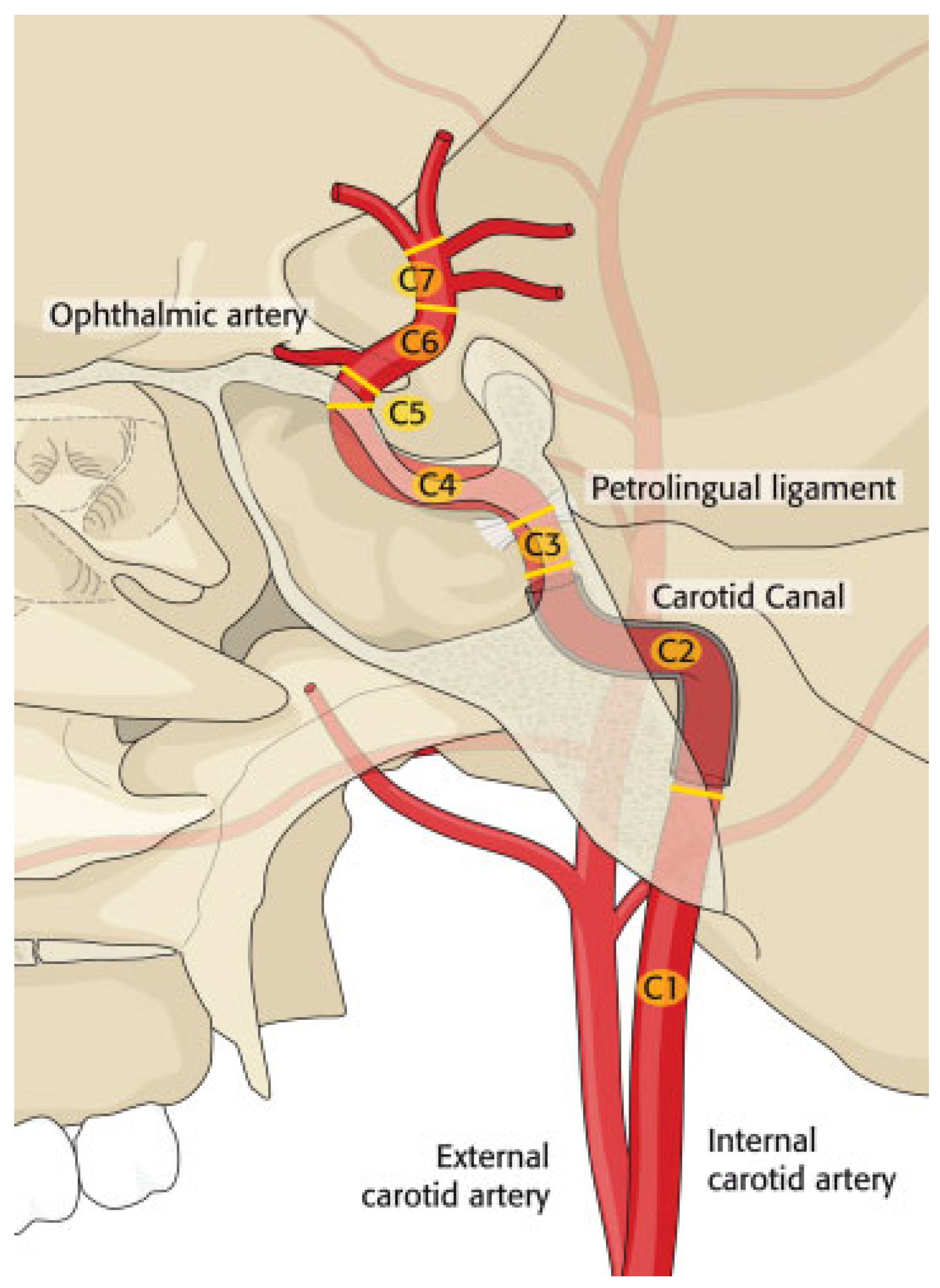
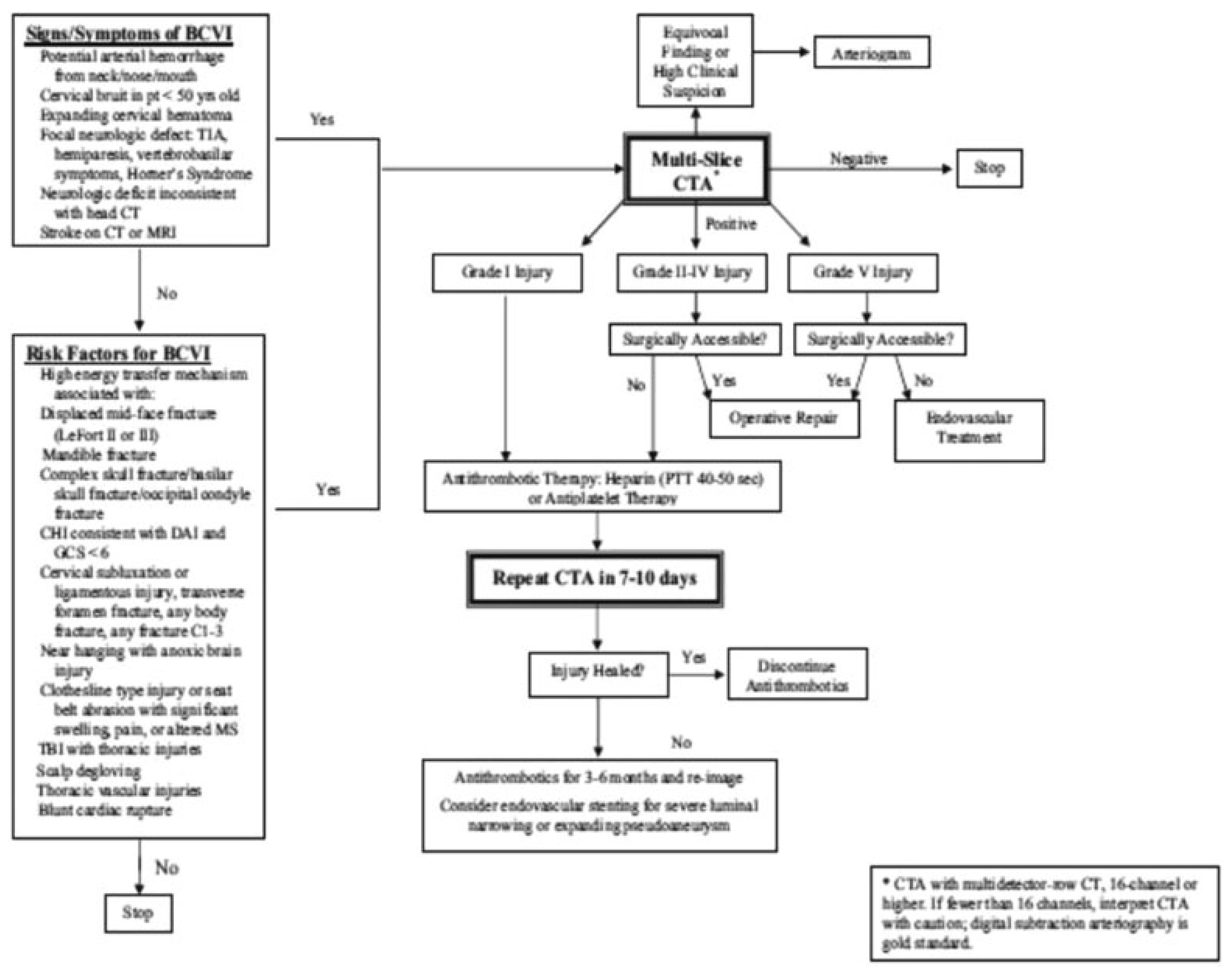
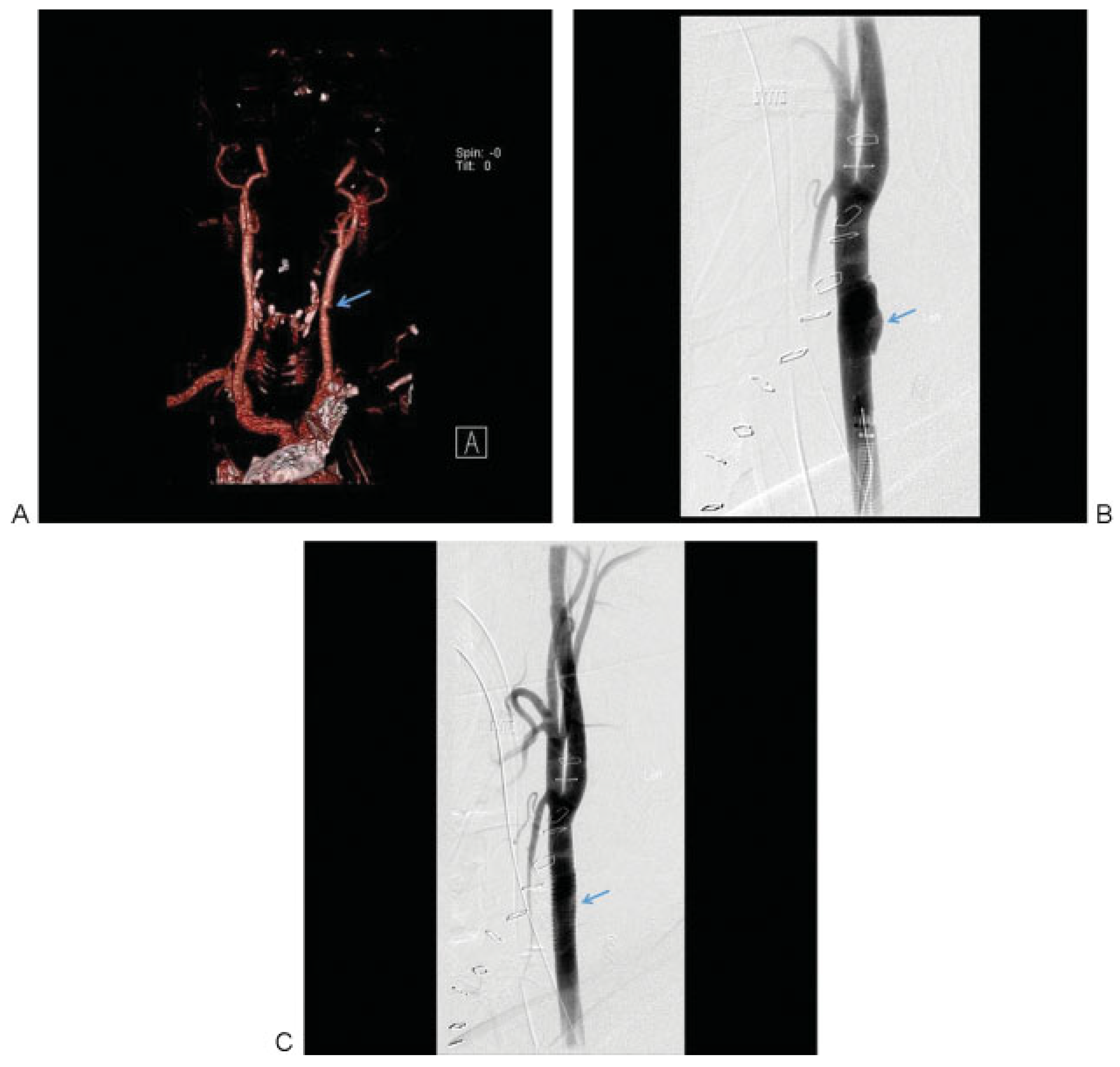
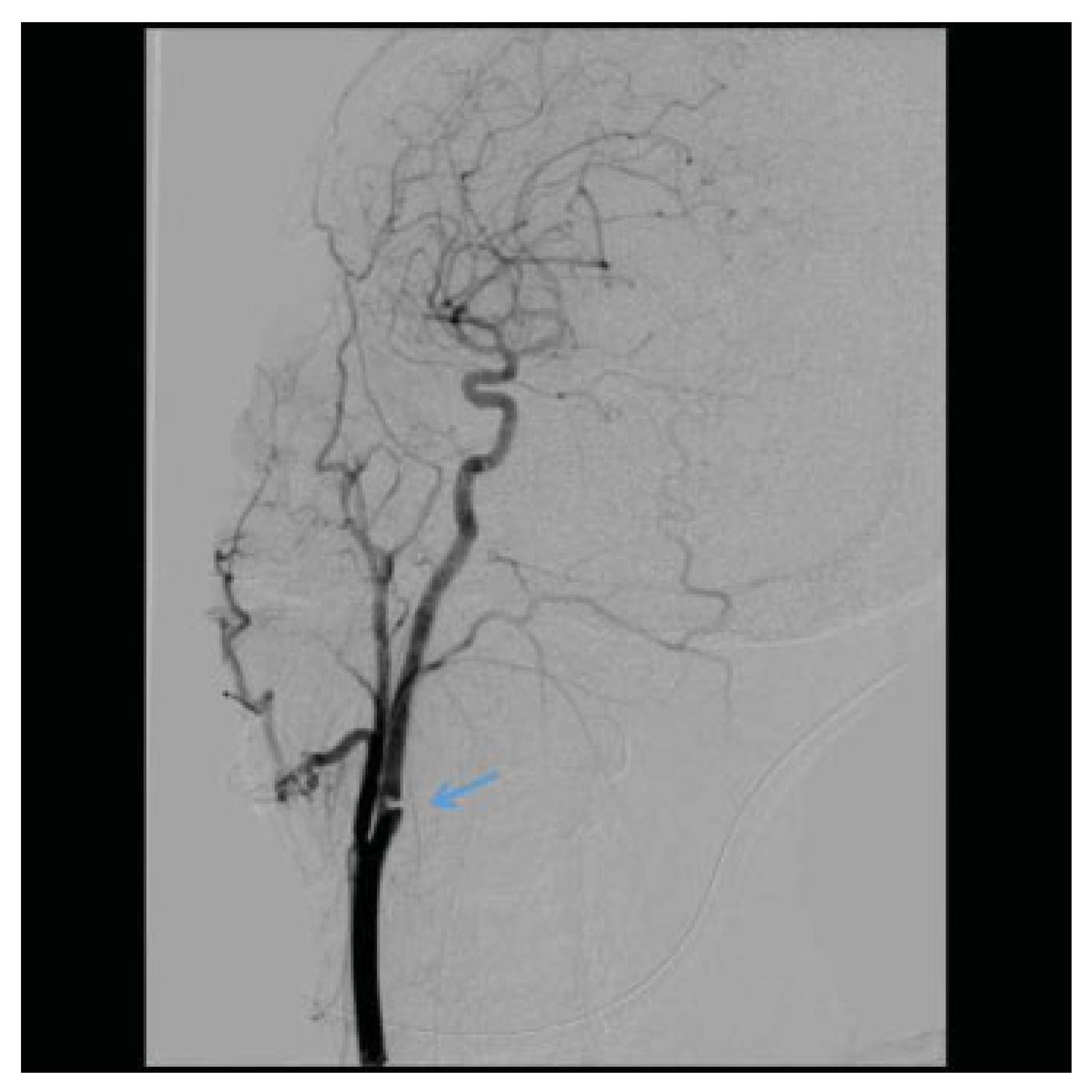
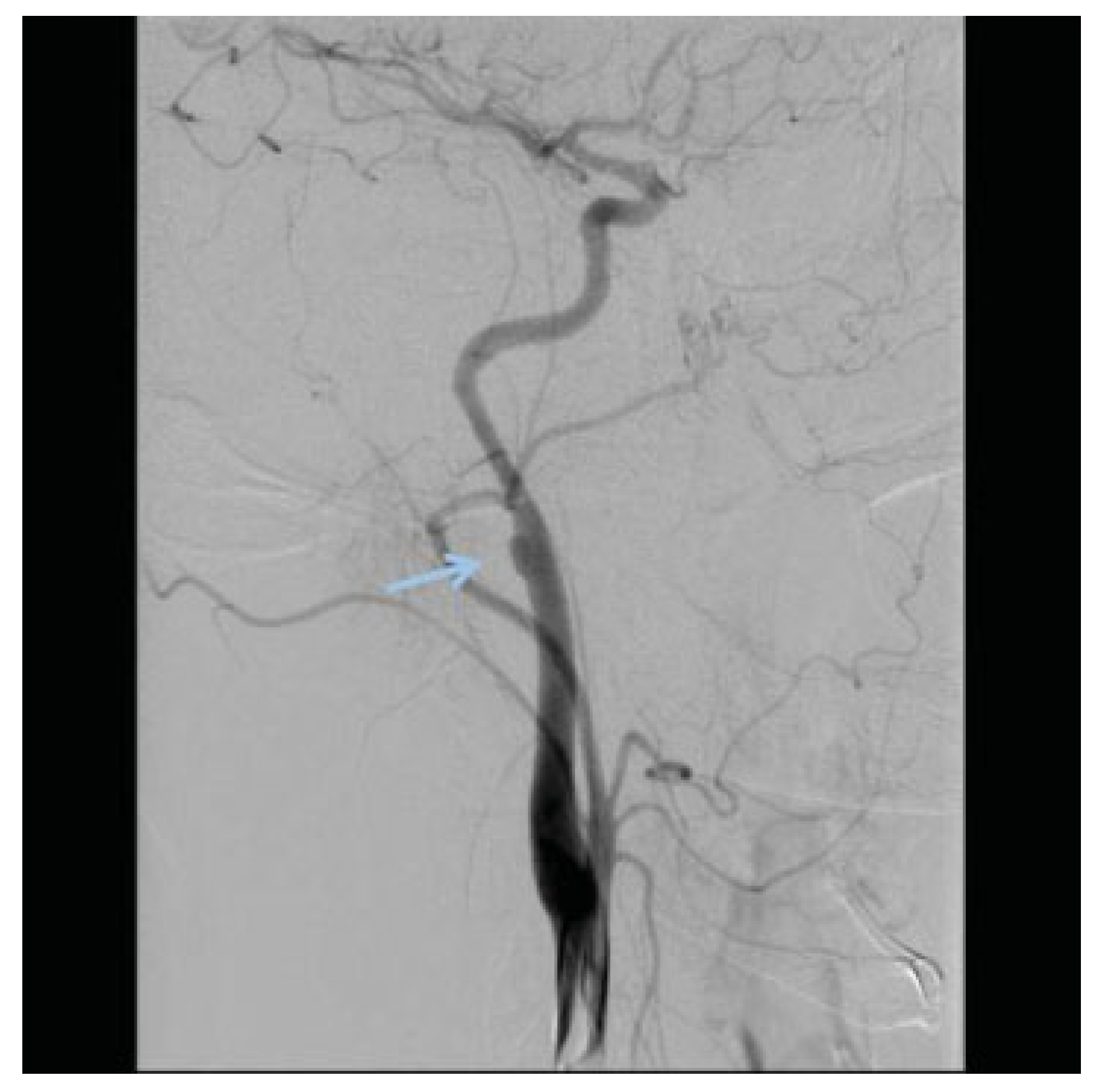
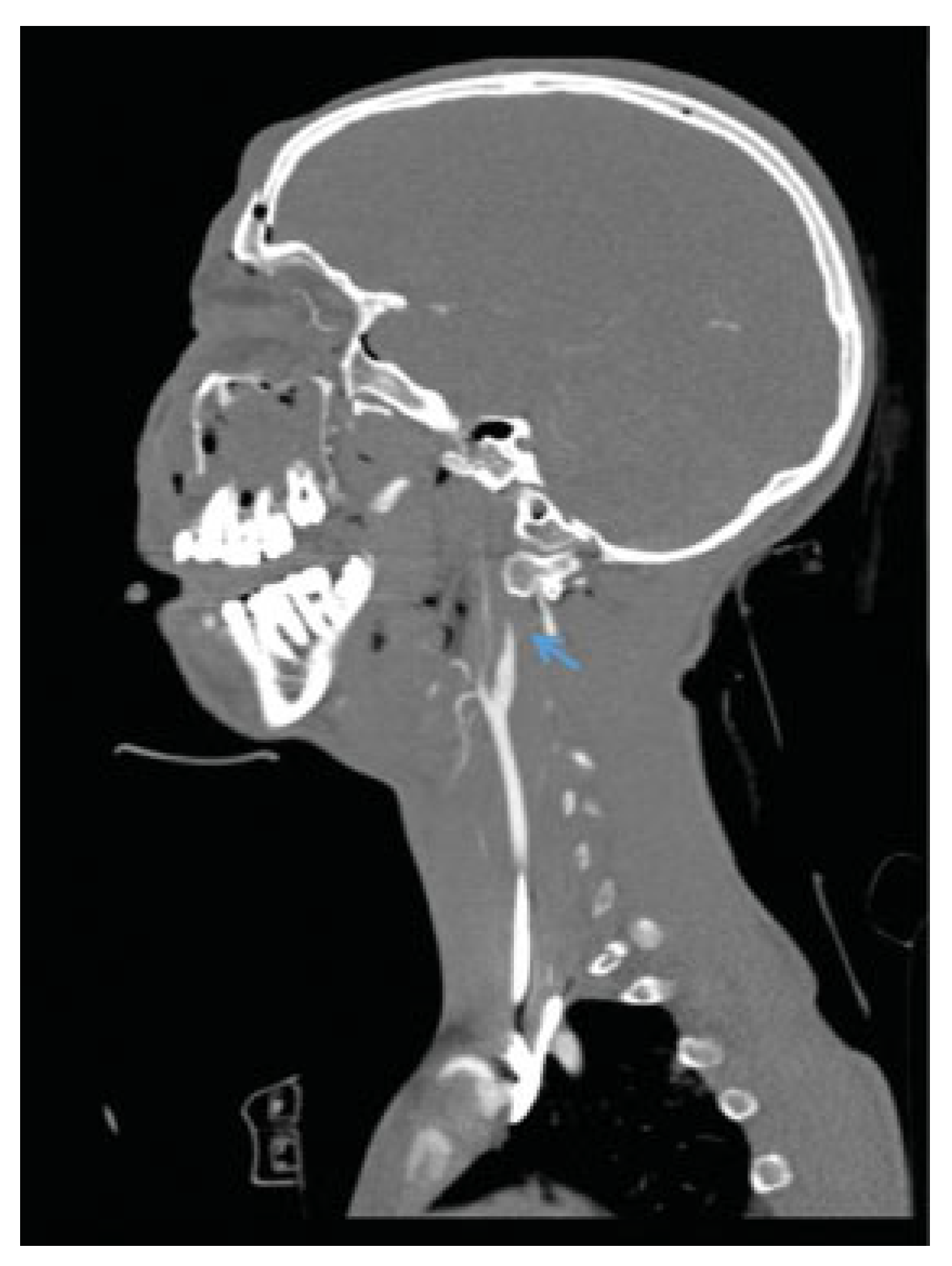
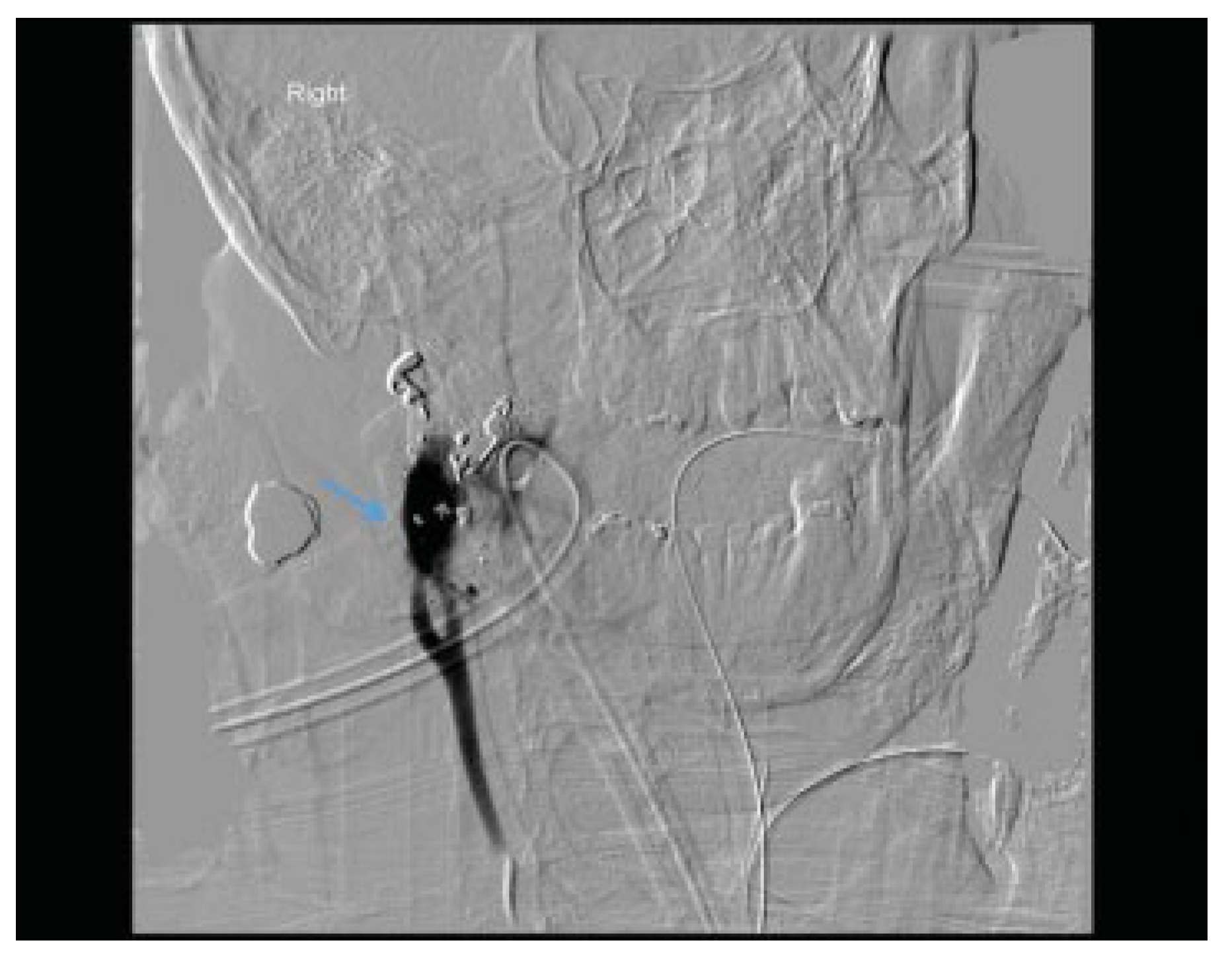
| Grade | Distribution (%) | Stroke rate (%) | Mortality rate (%) | |
|---|---|---|---|---|
| I | Luminal irregularity with < 25% luminal narrowing | 47.3 | 3 | 11 |
| II | ≥ 25% luminal narrowing, intraluminal thrombus, or raised intimal flap | 11.8 | 11 | 11 |
| III | Pseudoaneurysm | 23.7 | 33 | 11 |
| IV | Occlusion | 11.8 | 44 | 22 |
| V | Vessel transection | 5.2 | 100 | 100 |
| Screening criteria | |||
|---|---|---|---|
| Denver group | Memphis group | Kerwin et al [12] | |
| Signs/Symptoms |
|
|
|
| Risk factors | High energy transfer mechanism associated with:
|
|
|
© 2014 by the author. The Author(s) 2014.
Share and Cite
Lee, T.S.; Ducic, Y.; Gordin, E.; Stroman, D. Management of Carotid Artery Trauma. Craniomaxillofac. Trauma Reconstr. 2014, 7, 175-189. https://doi.org/10.1055/s-0034-1372521
Lee TS, Ducic Y, Gordin E, Stroman D. Management of Carotid Artery Trauma. Craniomaxillofacial Trauma & Reconstruction. 2014; 7(3):175-189. https://doi.org/10.1055/s-0034-1372521
Chicago/Turabian StyleLee, Thomas S., Yadranko Ducic, Eli Gordin, and David Stroman. 2014. "Management of Carotid Artery Trauma" Craniomaxillofacial Trauma & Reconstruction 7, no. 3: 175-189. https://doi.org/10.1055/s-0034-1372521
APA StyleLee, T. S., Ducic, Y., Gordin, E., & Stroman, D. (2014). Management of Carotid Artery Trauma. Craniomaxillofacial Trauma & Reconstruction, 7(3), 175-189. https://doi.org/10.1055/s-0034-1372521



